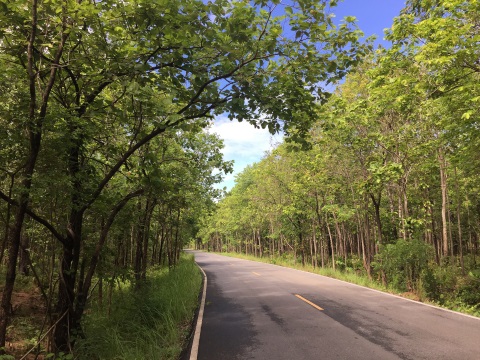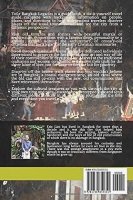| Back to Back Issues Page |
 |
|
Bangkok Travelbug August 2019 Huai Kha Khaeng Wildlife Sanctuary August 02, 2019 |
| Hello
Huai Kha Khaeng is part of the Thung Yai - Huai Kha Khaeng Wildlife Sanctuary that consists of two wildlife sanctuaries; viz the Thung Yai Naresuan and Huai Kha Khaeng. These two sanctuaries form an area of continuous forest that stretches along the Thai-Myanmar border from Kanchanaburi in the south to Uthai Thani and Tak in the north. It’s more than 300 km from north to south and covers an area 6,222 sq. km (1.54 m acres). In Uthai Thani Province, the Huai Kha Khaeng Wildlife Sanctuary covers almost half the province and most of the western districts of Ban Rai and Lan Sak. The terrain in these sanctuaries consists of long forested ridges running from north to south at heights of about 1,500 m and valleys that are 250 m – 400 m above sea level. 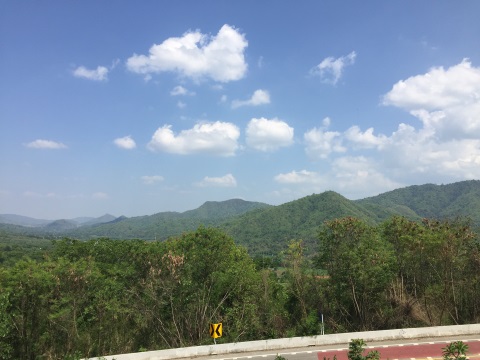
View of the terrain in Huai Kha Khaeng in Ban Rai District The area is home to numerous wildlife species including 120 mammals, 400 birds, 96 reptiles, 43 amphibians, 113 fresh water fish! Many of these are endangered species, there are at least 28 endangered species in this area. One-third of mainland South-East Asia's mammals live here! 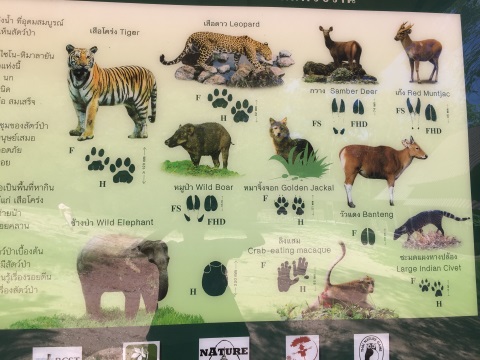
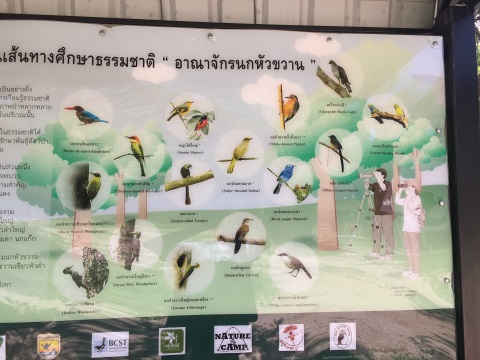
Some of the animals and birds found in the wildlife sanctuary In December 1991, UNESCO certified the Thung Yai – Huai Kha Khaeng Wildlife Sanctuary as a World Heritage Site, the first of its kind in South-East Asia. 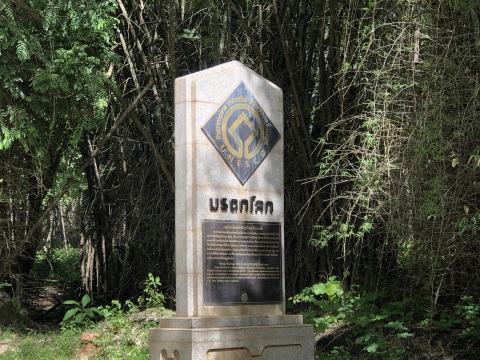
UNESCO recognition On 29 July 2019, Hollywood actor Leonardo DiCaprio posted on Instagram that the tigers in Huai Kha Khaeng has risen from 41 – 66, a 60% increase! He complimented Thailand for its long-term conservation efforts. The Leonardo DiCaprio Foundation supports tiger conservation. DiCaprio is also a member of the World Wildlife Fund's "Save Tigers Now" campaign. Contents Ranger Station and Admin HQ The Ranger Station is one of the two places in the Huai Kha Khaeng Wildlife Sanctuary that is open to the public. The other place is the Huai Kha Khaeng Breeding Station which we will be visiting later. This Ranger Station consists of the following facilities:
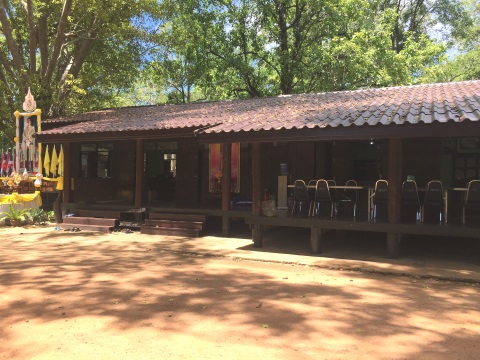
The Ranger Administrative building The World Heritage Museum building had an electricity black out on the day of our visit and was closed to the public for the day. From this station visitors can branch out to nature trails and a camp site. As we didn't have time, we omitted these places. But we more than made up for this, as we shall see later. Contents Sueb Nakhasathien Memorial The Sueb Nakhasathein Memorial preserves the memory of the man who was instrumental in getting Huai Kha Khaeng Wildlife Sanctuary, together with the adjacent Thung Yai Naresuan Wildlife Sanctuary to the south recognised as a UNESCO World Heritage site for nature. 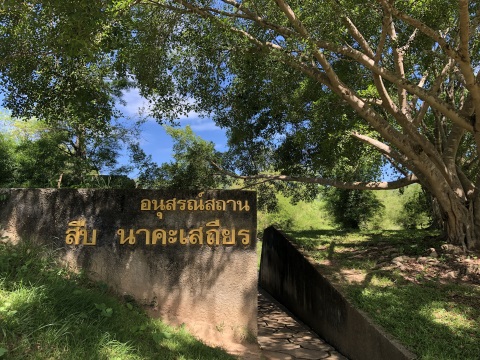
Entrance to the memorial To the side of the entrance stand statues of a tiger and tiger cub as if guarding the entrance to the memorial for the man responsible for preserving their habitat, a fitting symbolism. 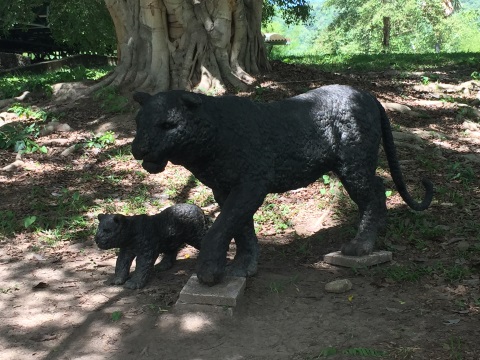
Sentinels at the gate 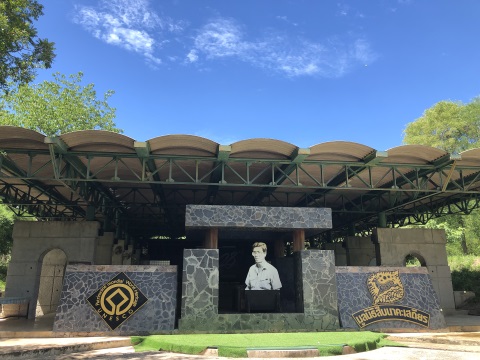
Inside the memorial The interior is designed like an amphitheatre for presentations and services. 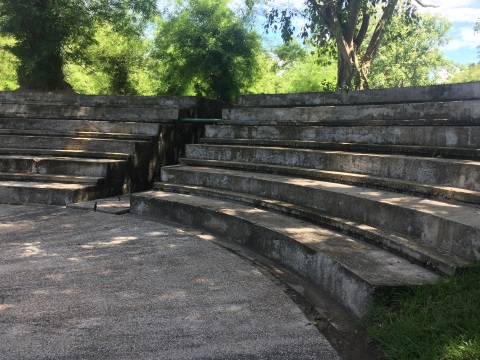
The amphitheatre Information boards in Thai and English are mounted on pillars relate to visitors about the life of Sueb Nakhasathein. It is worthwhile looking into the details of the life, career and beliefs of this extraordinary man who has served the cause of conservation of the forests and wildlife in Thailand so well. Early Life and Career Sueb Nakhasathien was born on 31 December 1949 in Prachinburi Province, the son of the governor of that province. A brilliant student, he did well in school and in 1969 took up Forestry in Kasetsart University. He graduated in 1973 and returned a year later to take his Masters in silviculture, a branch of forestry dealing with the development and care of forests. 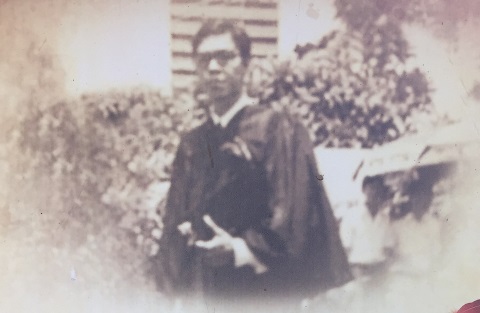
Sueb on graduation In 1975 he joined the Wildlife Conservation Bureau in the Royal Forestry Department. In 1979, he won a scholarship to take his Masters in Resource and Environmental Conservation in the University of London. 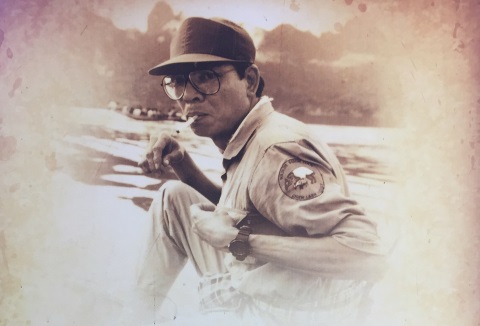
As a forestry officer In 1983 he returned to the Wildlife Conservation Bureau to do pursue his passion in research on conservation, in the course of which he produced several research papers. In 1986, Sueb led a team to evacuate the wildlife endangered by the construction of the Ratchaprapa Dam in Surat Thani. The massive destruction of the forest and wildlife left a deep impression on him. He devoted his life to saving forests and wildlife and advocating against the construction of dams. 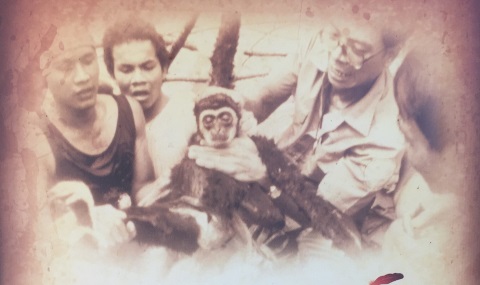
Saving the animals In 1989 Sueb Nakhasathein became superintendent of Huai Kha Khaeng Wildlife Sanctuary, Thailand's most valuable protected forest. Sueb's Beliefs Sueb was dead against the construction of dams because of the destruction of forest which is the habitat and source of food for wildlife. He led a public campaign that succeeded in stopping the Nam Chon Dam in the Thung Yai Naresuan Wildlife Sanctuary. "Wildlife sanctuaries are vital to enable protection of all their variety of animals and other creatures each of which needs a specific habitat comprising of specific plants, trees and terrain." His action provided the impetus for the conservation movement in Thailand. He continued to give talks to raise awareness to the destruction of forests that was going on in Thailand. 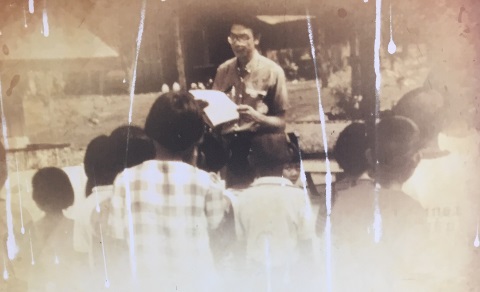
Speaking up for the animals "I am here to speak on behalf of the animals, who cannot speak for themselves." Sueb believed that conservation is a three-prong effort; research, enforcement and reaching out to communities. The first two aspects are clear cut, the third consisted of educating the public to create awareness. In this way, the local communities around the forests can help to protect the forests as well. Sueb sympathised with the landless forest dwellers, some of whom have lived in the forests for generations, long before these forests were declared reserved areas. He proposed a 5 km buffer zone around the forests where landless forest dwellers can be allowed to live legally and engage in farming on condition that there is no destruction to the forests and wildlife. 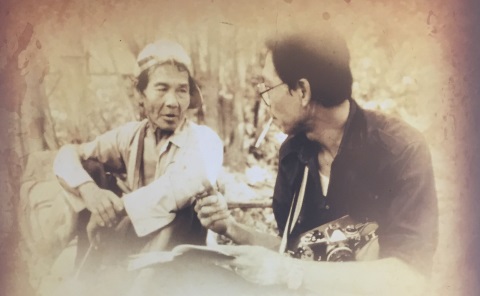
Reaching out to the local communities Sad to say, today many forest dwellers are still landless and subject to constant harassment from officials. Poaching and logging still occur and unfortunately, it's the hapless forest dwellers who are prosecuted not the real culprits. Lastly, Sueb maintained that wildlife sanctuaries should be open to the public to create public awareness of the importance of these forests, to wildlife and the environment. 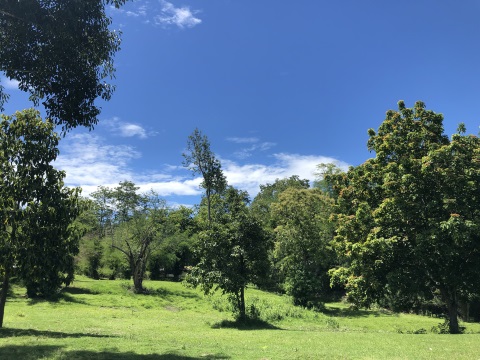
Lush greenery around the Ranger Station "We pay a lot of attention to conservation, but we have to understand that wildlife conservation is much more than simply keeping wildlife alive. For those who like to keep wild animals in a cage, to keep as pets, I tell you that nature can raise your pet much better than you can. And I plead to those who enjoy hunting wild animals or buying wild meat to stop." Sueb's Experience at Huai Kha Khaeng When Sueb assumed the post of superintendent of Huai Kha Khaeng Wildlife Sanctuary, he was appalled by the rampant illegal logging and poaching taking place. 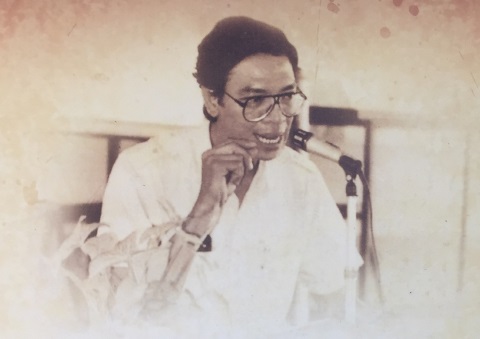
As superintendent of Huai Kha Khaeng This came from two quarters; first the local forest communities, some of whom were landless and were trying to make a living from the forest, second wealthy locals with power and influence were backing large scale illegal logging and poaching. To make matter worse, his superiors were indifferent to the ravage to the forest and wildlife as some were corrupted or even directly involved. His staff were under-paid, poorly equipped and poorly armed. Several of his rangers were killed when they tried to apprehend loggers and poachers. These deaths placed a terrible burden on him. One benefit Sueb provided for his rangers was to set up a welfare fund to supplement their meagre salaries and provide insurance for them. He even borrowed money from his mother to pay his staff first when their salaries were delayed. Tragic End Sueb's uphill battle against an unsupportive bureaucracy whose priorities were elsewhere, was beginning to take its toll on his morale. On 1 September 1990, he entrusted his research equipment to the Khao Nang Rum Wildlife Research Centre nearby and set up a memorial for the rangers who lost their lives. Then he shot himself in his bedroom. "If there is another who must die protecting Huai Kha Khaeng, it should be me." On 9 December 1991, UNESCO recognised the wildlife sanctuaries of Thung Yai Naresuan and Huai Kha Khaeng together as a World Heritage site for nature, a first for Thailand. Sueb's dream of the conservation and protection of these sanctuaries as one entity has been realised. Sueb's suicide shocked the nation and heightened public attention to the destruction of the forests and wildlife. With UNESCO recognition, subsequent governments were pressured to provide the funds and preserve the forest. Sueb's house at the Ranger Station is preserved in his memory. It's a simple wooden house with a balcony in front with a table where he held his meetings or had dinners, a bedroom to one side and his office to the other. The bedroom and office can only be viewed from the outside. 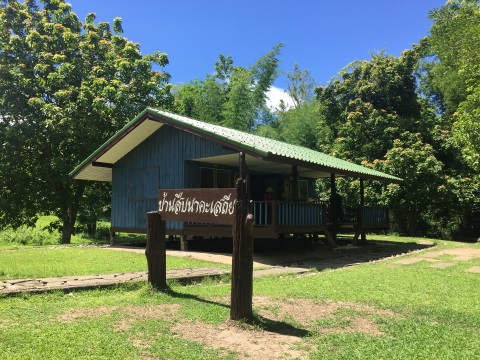
Sueb Nakhasathien's house 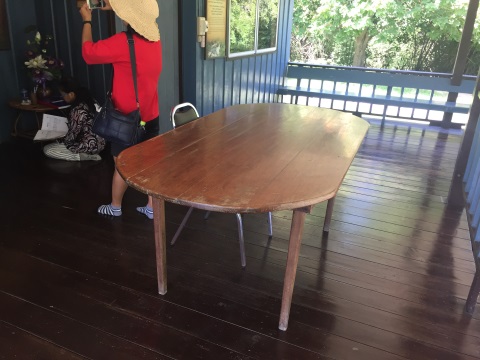
The balcony and table in Sueb's house 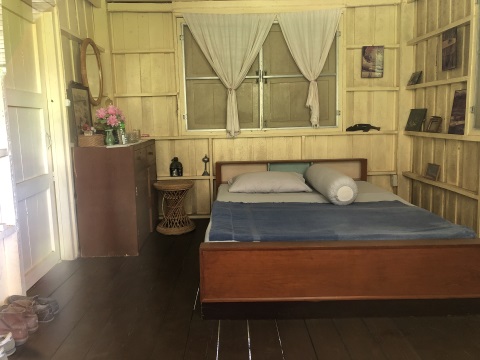
Seub's bedroom where he shot himself 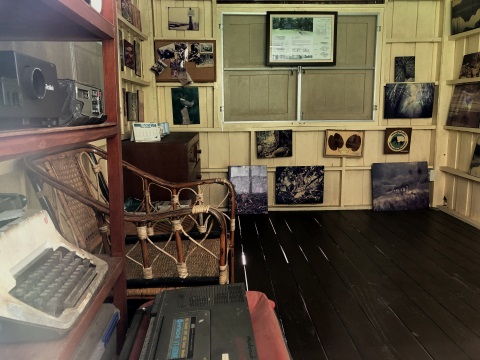
Sueb's office Sueb's statue stands some 30 m away from his house. 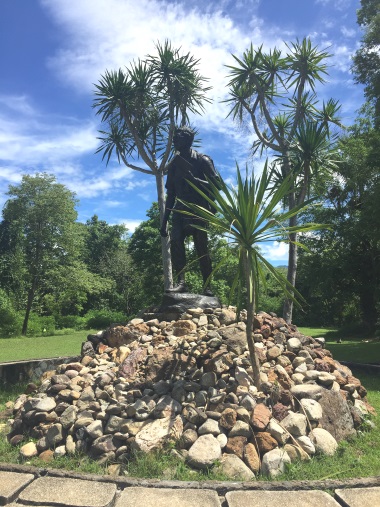
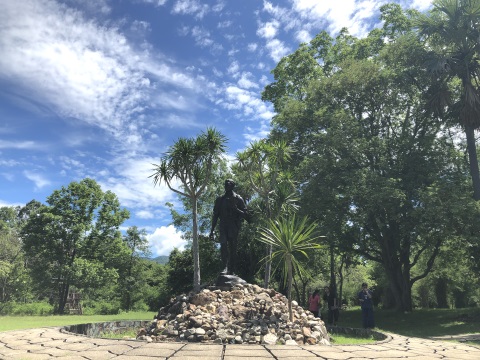
Statue in Sueb's memory Contents Ranger Memorial We had an idea of the work routine of the forest rangers from one of them who was kind enough to explain. The forest rangers go out on patrols for 15 days at a time to check on the forest and the wildlife. Each patrol covers a specific sector and over time, a large section of the forest is surveyed. While on these patrols they live and cook their meals in the forest. At the end of the patrols they spend 15 days resting and doing administrative duties in the base camp. Accommodation is on the base. Bear in mind that the camp is 30 km from Lan Sak, the nearest town, a small town, 65 km from Nong Chang, a bigger town and 86 km from Uthai Thani City. During these patrols they check on damage to the forest by illegal loggers and harm to the wildlife by poachers. In the course of these duties, some of them have lost their lives to the illegal loggers and poachers. Just before he died, Sueb Nakhasathien dedicated this Rangers' Memorial to these brave rangers who lost their lives in the course of their duties. 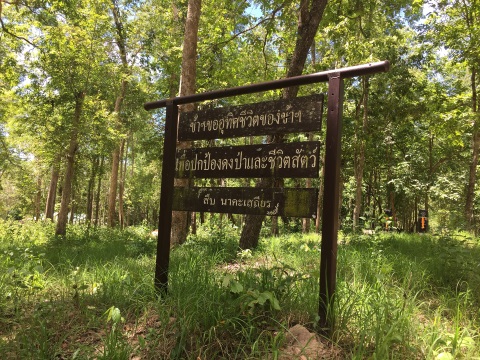
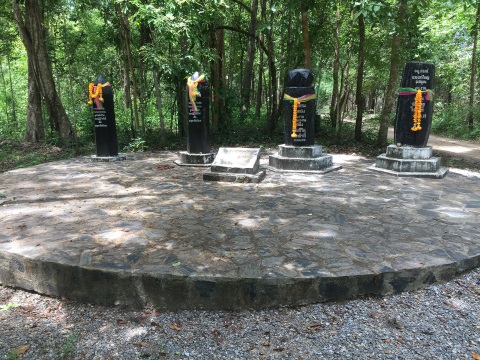
Dedicated to those who sacrificed their lives to protect the forest and wildlife On 31 July 2019, World's Ranger Day, it was announced that from 1 January – 31 July 2019, 14 rangers in Thailand have been killed in the line of duty. Contents Wildlife Sightings As I was walking towards the Rangers' Memorial, I noticed this herd of deer grazing under the trees to my right. I kept my distance from them and walked on slowly so as not to scare them off. They looked curiously at me. 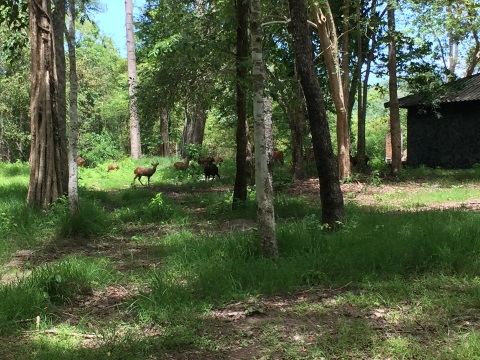
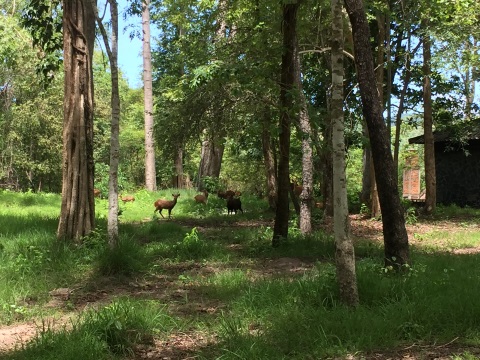
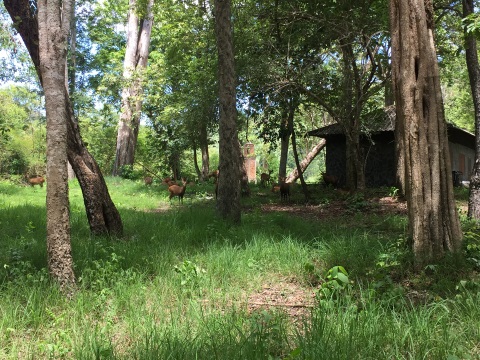
A chance sighting A ranger later explained that there are two species of deer in the wildlife sanctuary; the brow-antlered deer or Eld's deer (la meng in Thai) and the hog deer (nuea sai in Thai). The brow-antlered deer (Cervus eldi) was first discovered in Manipur India and was named Eld's deer in honour of Lieutenant Percy Eld, the British officer at the residency in Manipur. Eld's deer, which can be found in Myanmar, Thailand, Laos, Cambodia, China and Vietnam, is an endangered species. The hog deer (Axis porcinus) is found in Pakistan, Northern India, Myanmar, Thailand, Cambodia and Vietnam. It's also an endangered species. We had the chance to sight more wildlife later when we were having lunch in the canteen overlooking the river. A deer (I can't tell which species) was wandering in carpark before it crossed the river to our right to graze under a tree on the other bank right across from where we were having lunch. 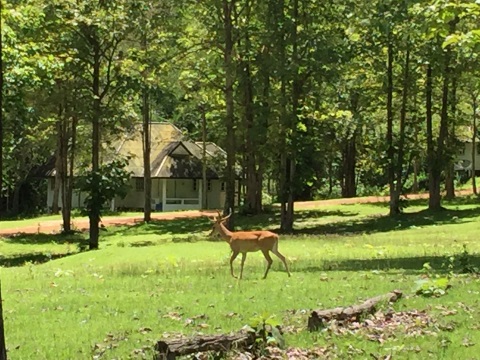
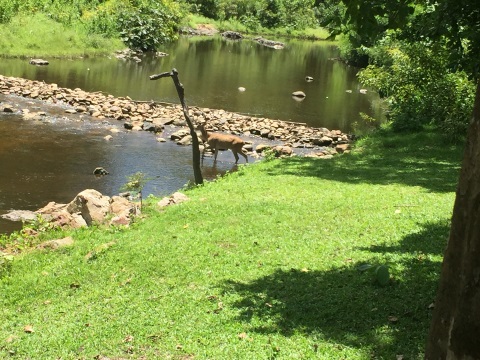
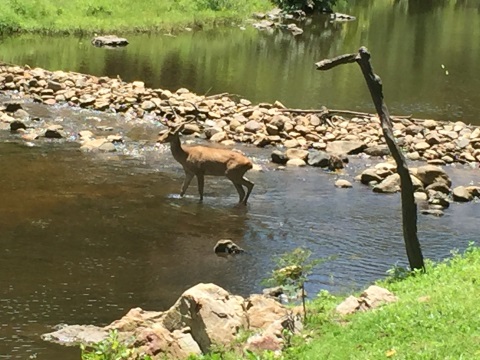
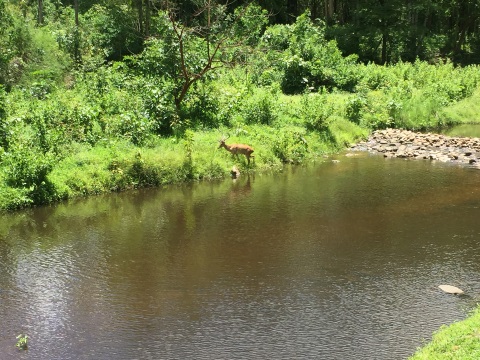
What's for lunch? That was when it got more interesting, a herd of wild boars on a lunch outing crossed the river to our left to graze under the same tree where the deer was grazing. The deer by then had made a discreet exit. 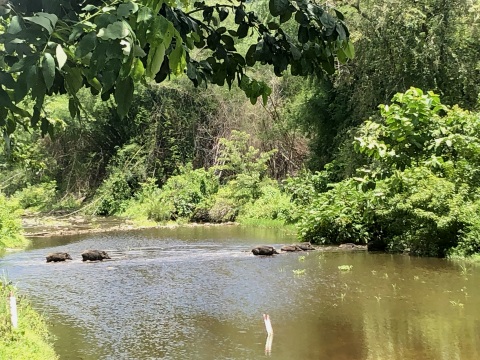
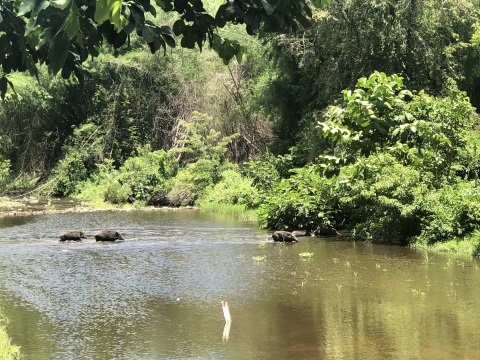
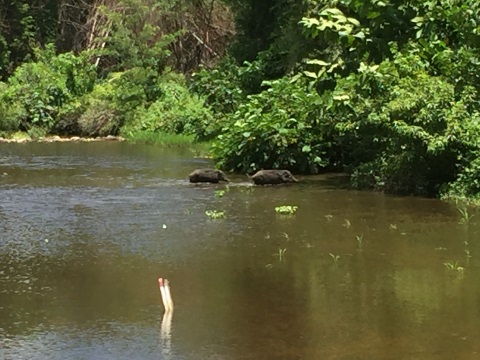
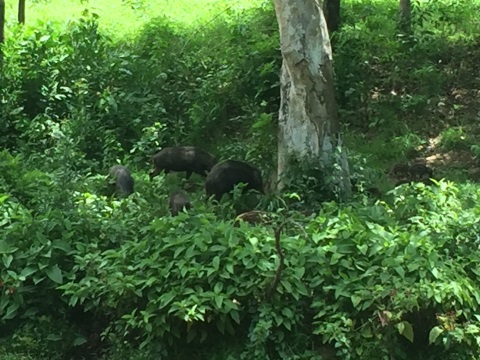
Bob and family on a lunch outing At our next stop we got to see more wildlife from this sanctuary. Contents Huai Kha Khaeng Wildlife Breeding Station In the course of a forest ranger's work, he may come across young animals that are lost, left behind by the herd or injured. These animals are taken to the Huai Kha Khaeng Wildlife Breeding Station where they are nursed and nurtured. When they are well and grown enough to fend for themselves, they are released back to the wild. The breeding station is about 8 km to the east of the main entrance to the sanctuary. It was a pleasant drive across beautiful terrain. 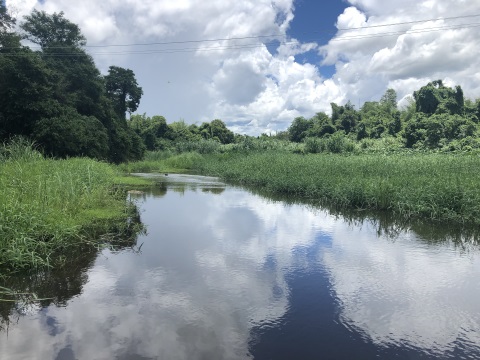
On the way to the breeding station 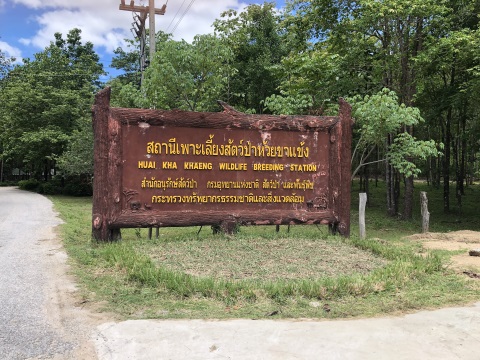
Huai Kha Khaeng Breeding Station The first enclosure we visited happened to house my favourite animal, the bear, the Asiatic Black Bear (Ursus tibetanus, mi kwai in Thai). They are widely found in Myanmar, Laos, Cambodia, Vietnam and Thailand. They can also be found in North-east China, Far East Russia and Japan. The Asiatic Black Bear is an endangered species. There were three of these bears in three separate enclosures; two were lazing in their shelters to the rear but the third lumbered along to the front to greet the visitors. 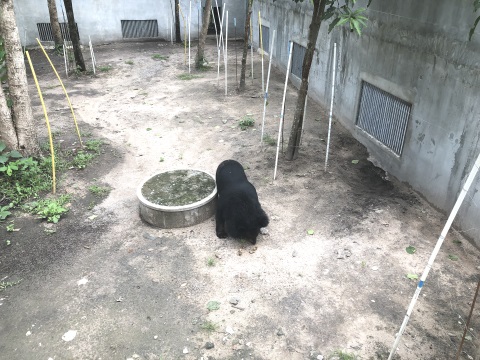
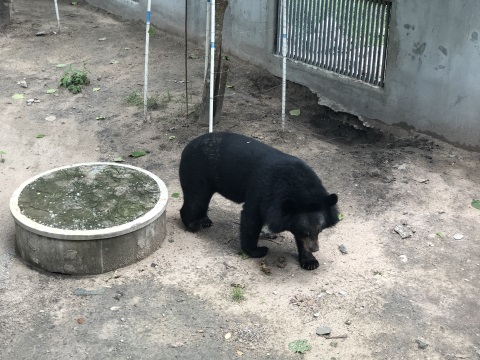
Look who's here 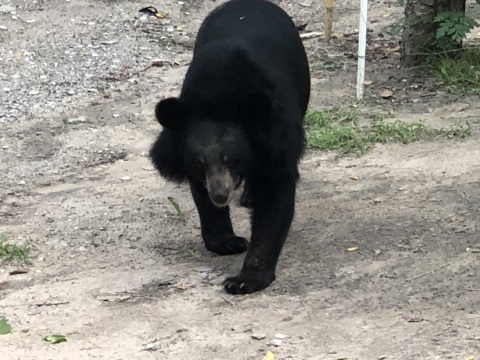
Beary nice of you to come out to see us 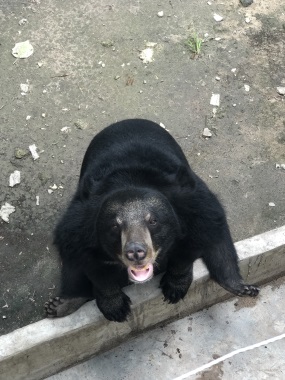
Hello Bruno Besides these bears, there were also some birds and other animals in the breeding station 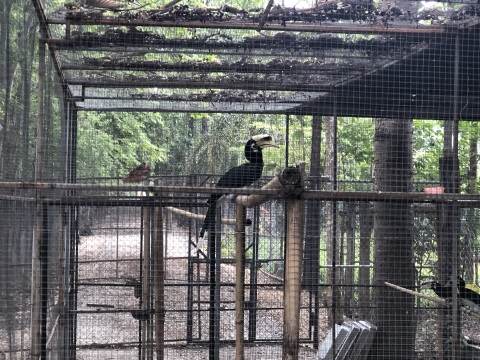
Hornbill 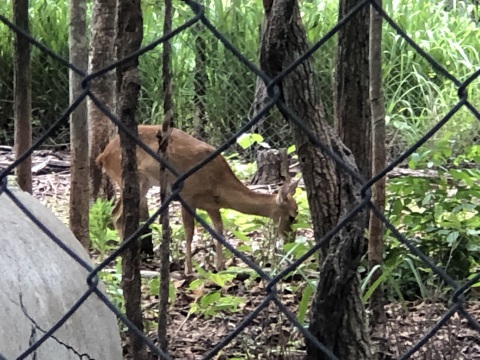
Deer 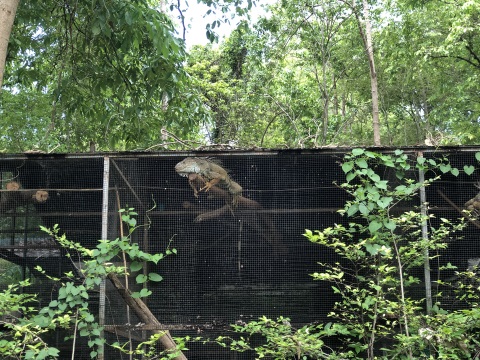
I can't identify this ugly thing! To round up our visit to the breeding station, we went back to the bears' enclosures. Bruno was still trying to clamber up the wall to greet the visitors. 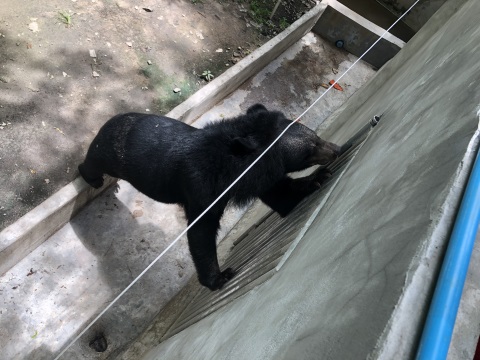
Bye Bruno That brings us to the end of our tour of the Huai Kha Khaeng Wildlife Sanctuary. We hope you enjoyed it. Take a trip there, it's definitely worth the journey. Contents Our thanks Our thanks to the rangers at the Huai Kha Khaeng Wildlife Sanctuary who gave us valuable information on the animals and their work routine. Our appreciation to all these men and women who have dedicated their lives to protecting and preserving the forest and the wildlife that live in it. We would also like to dedicate this article to Sueb Nakhasathien, the man who has done so much to make Huai Kha Khaeng Wildlife Sanctuary a reality. His was the ultimate sacrifice. 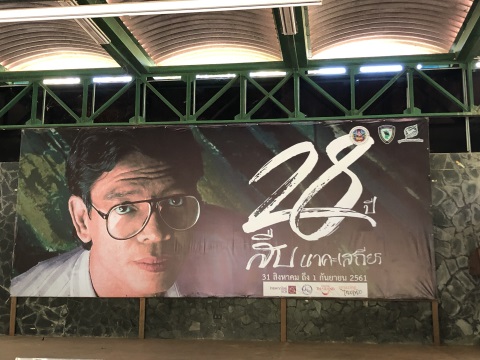
"If there is another who must die protecting Huai Kha Khaeng, it should be me." This article is also a dedicated to the 20,000 rangers in Thailand performing their duties in protecting the forests and wildlife and those who have lost their lives in doing so. Contents Map to Huai Kha Khaeng Wildlife Sanctuary If the map doesn’t appear, click on this link Address Huai Kha Khaeng Wildlife Sanctuary Rabam Lan Sak District Uthai Thani 61160 Tel: +66 84 373 3756 Opening hours 08:00 am – 04:00 pm Admission Foreigners 200 baht per person Thai 20 baht 30 baht per vehicle How to get there From Uthai Thani City go west along route 333 till you get to Nong Chang. After you have passed the town, turn right into route 3438. Stay on this route till you pass Lan Sak. You will get to the turning to the Huai Kha Khaeng Wildlife Sanctuary on the left. There is a big signboard at the junction. Follow the road till you get to the check point. 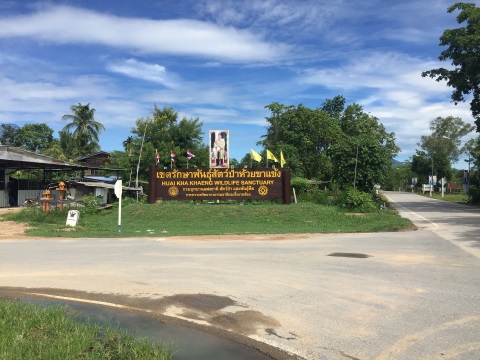
Huai Kha Khaeng Wildlife Sanctuary Have a safe and enjoyable trip! See you next month. Contents Next month Exploring Ban Rai, Uthai Thani If you enjoyed reading this e-zine, please forward it to a friend. If you received this from a friend and found it interesting, please subscribe at Bangkok Travelbug. What do you think of the Bangkok Travelbug? We love to hear from you What other subscribers have said Till next month then. Eric Lim Tour Bangkok Legacies Find us on Facebook Tour Bangkok Legacies - Kindle paperback edition For those who prefer reading printed books rather than e-books, here's the paperback edition of Tour Bangkok Legacies, which will help you along as you explore the streets of Bangkok and discover its old treasures. It's complete with historical descriptions and directions on how to get to these places. My Kindle paperback edition 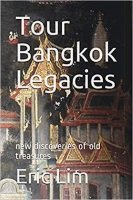
Copyright@2008-2019 Tour Bangkok Legacies All rights reserved
|
| Back to Back Issues Page |
